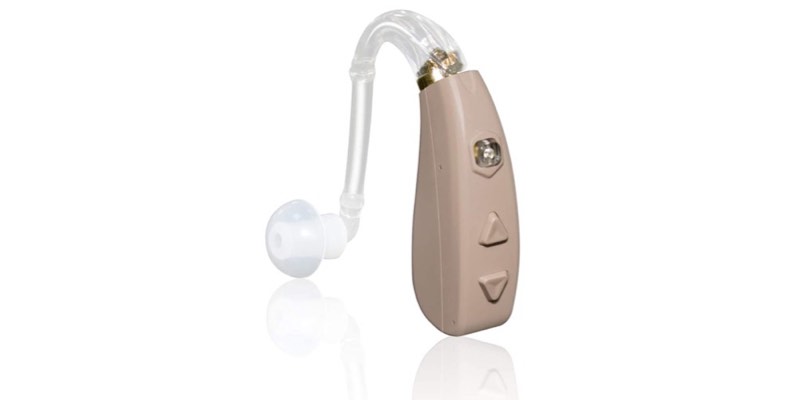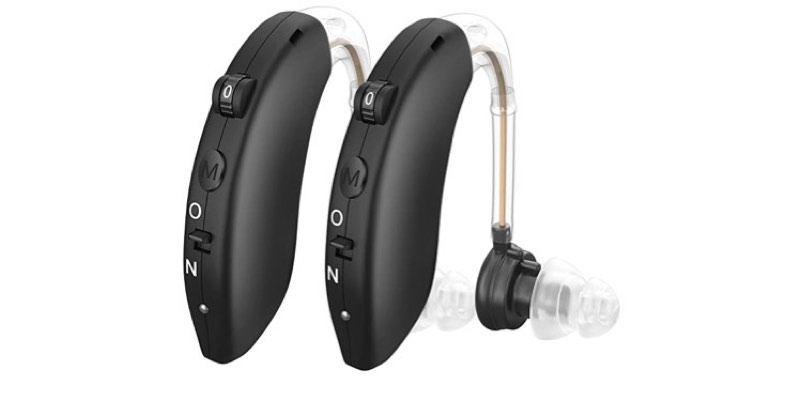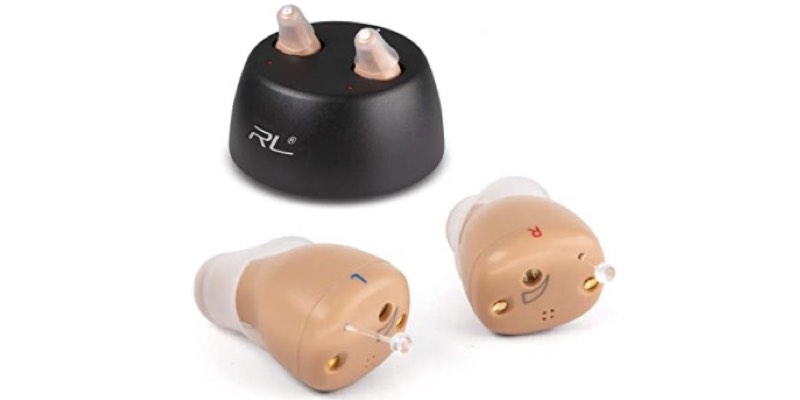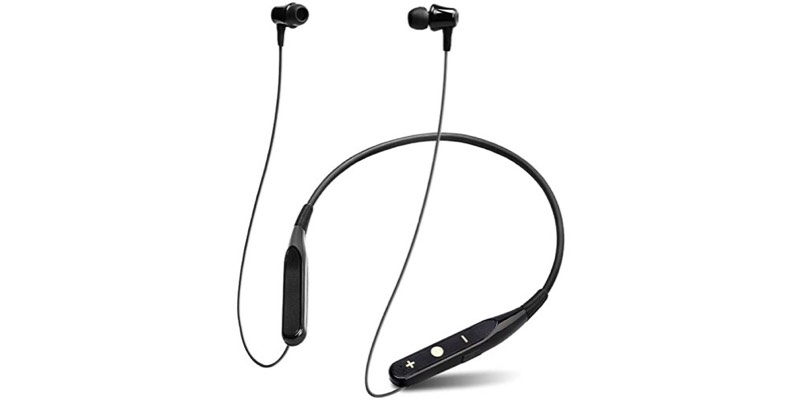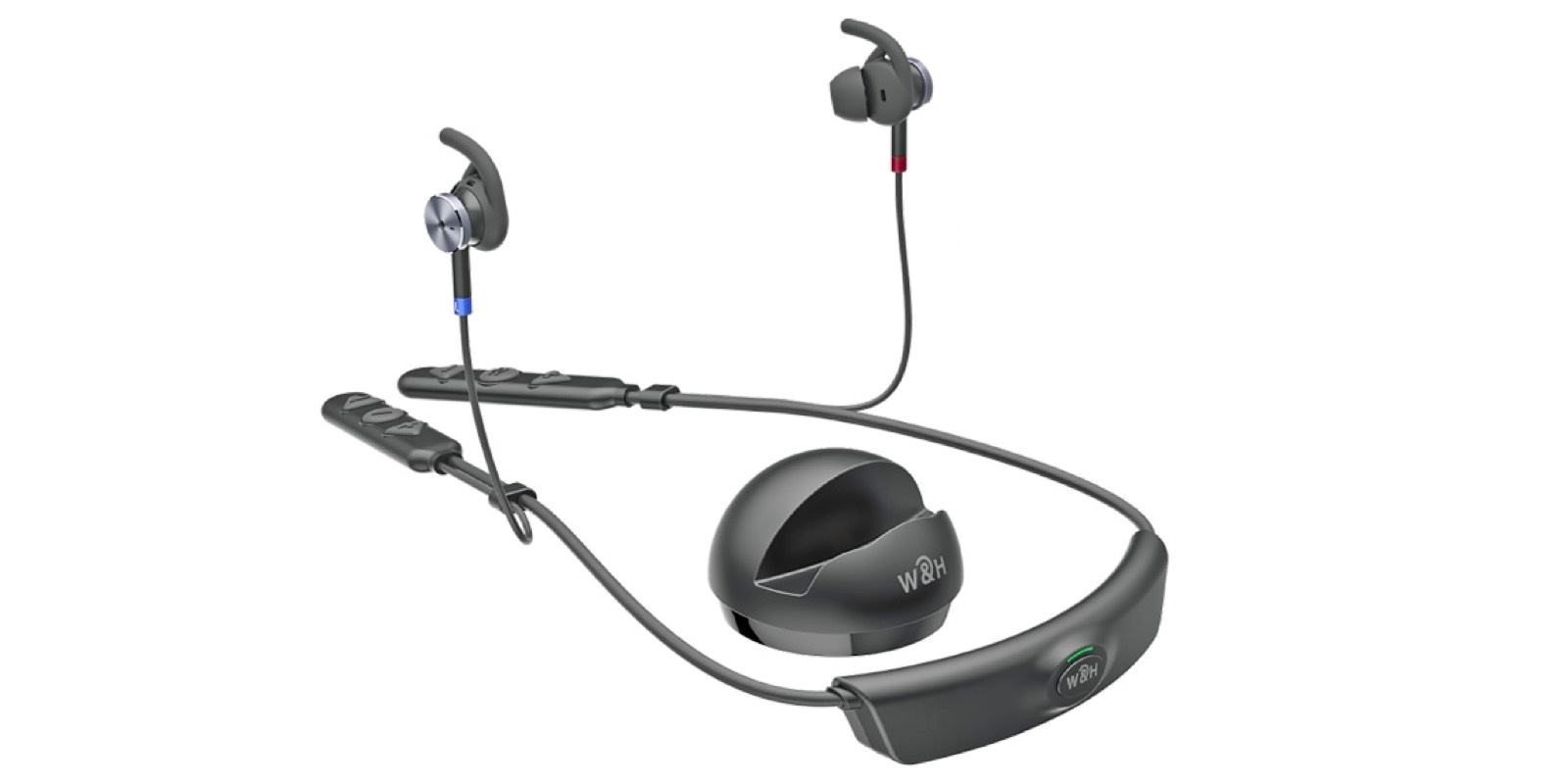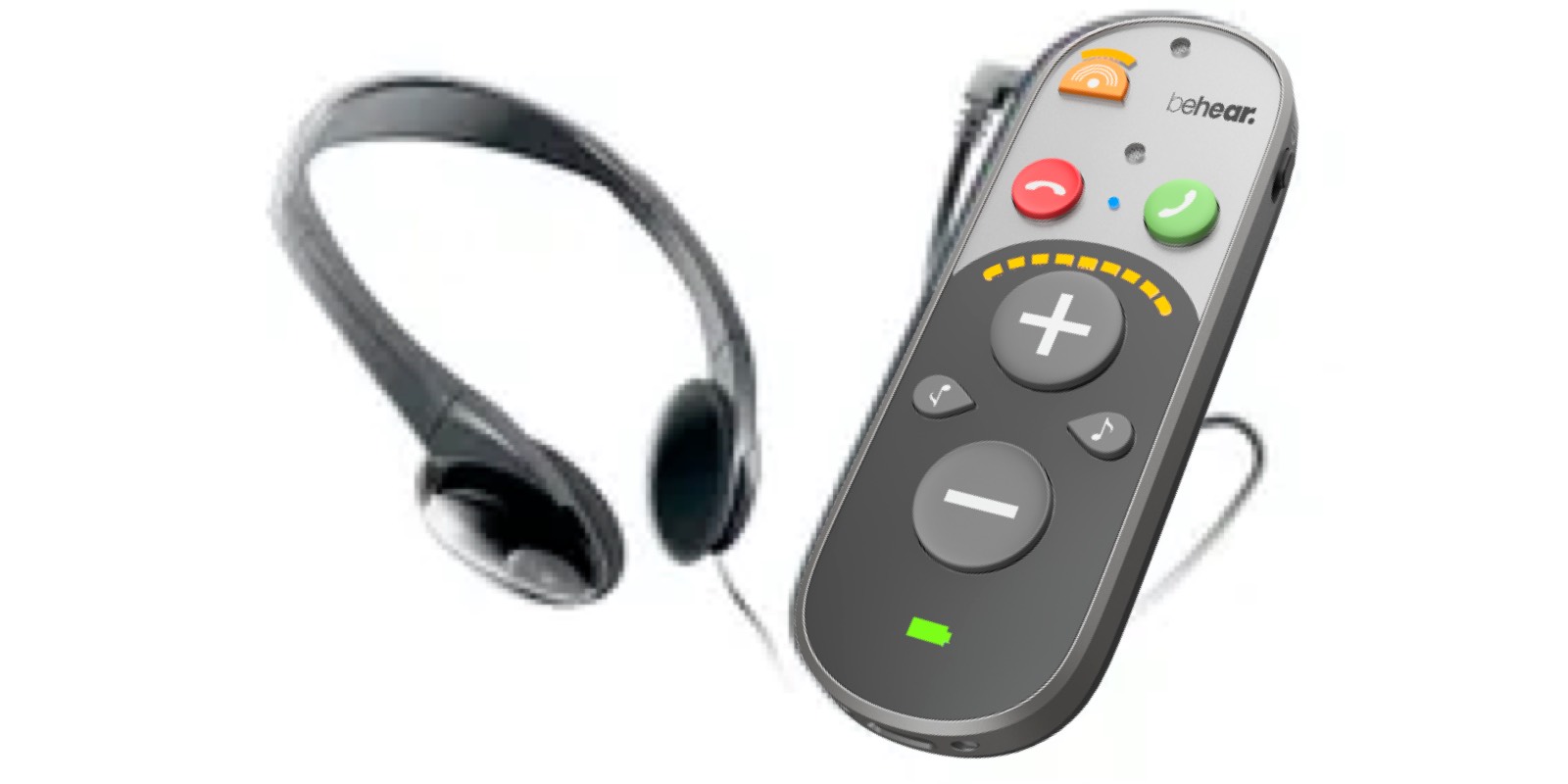Impaired hearing can make conversations, meetings, social gatherings and other settings frustrating. Hearing amplifiers pick up sounds to increase the volume you hear. Also called personal sound amplifiers, hearing amplifiers don’t do as much to customize sound levels as hearing aids. However, many find amplifiers work well for mild to moderate hearing loss at a much lower cost.
Use this guide to learn how digital hearing amplifiers work, your style options and how to choose the best hearing amplifier for your needs.
We evaluated 28 hearing amplifiers to help you find highly rated products. We considered consumer reviews, technology, cost and comfort. Our six best hearing amplifiers are BeHear amplifiers, iBstone K17, Banglijian ZIV-206, Enjoyee Hearing Amplifiers, R&L C20 and Neosonic NW 10.
Top tips:- Plan for limited wear for a couple of weeks to get used to hearing amplifiers.
- Consider how many hours you will wear hearing amplifiers each day and choose a model that will be comfortable.
- If the hearing amplifier is uncomfortable, use the return policy and try a different design.
Tips For A Wise Buyer
The World Health Organization reported in February 2021 that nearly 2.5 billion people worldwide will experience some degree of hearing loss by 2050. Not everyone in this projection will need to wear hearing aids. Many will discover hearing amplifiers as an affordable alternative, just as many people do today.
Those with mild to moderate difficulty hearing are often pleased with hearing amplifiers and save thousands of dollars compared to those who buy hearing aids. Today’s hearing amplifiers are lightweight, and some are small enough to wear entirely in the ear.
What is a Hearing Amplifier?
Hearing amplifiers capture sound in your surroundings, then use digital processing to produce the same sound at a level you can hear. While there are a few differences between hearing aids and hearing amplifiers, the most noticeable is that amplifiers are not as sound-selective.
A hearing amplifier generally makes all sounds louder. A hearing aid can increase specific sounds you have trouble hearing, like high-pitched sounds. That said, there are some excellent hearing amplifiers designed with technology that allows for a more customized hearing experience.
Hearing amplifiers process sounds to make them louder.
The Journal of the American Medical Association (JAMA) and the National Academy of Sciences performed studies comparing hearing aids to hearing amplifiers. Both studies revealed there is a place for both devices in the treatment market.
Hearing Amplifier Styles
Most hearing amplifiers resemble a type of hearing aid. All of the products we selected are small or slim enough not to be obvious when worn. However, those with small ears may find it challenging to find a discreet hearing amplifier.
| Hearing Amplifiers Models | |
|---|---|
| Design | Use and Benefits |
| Behind-the-ear | – Resembles a hearing aid with a receiver worn securely behind the ear lobe.– Many have slim receivers that are barely noticeable.– BTE hearing amplifiers typically fit left and right ears differently. |
| Completely-in-canal | – CIC hearing amplifiers fit directly in the ear.– Less noticeable during wear.– Small enough to be difficult to handle if you don’t see well. |
| Headsets with earbuds | – Amplifier processor is enclosed in a flexible neckband.– Small earbuds are comfortable for most people.– Bluetooth hearing amplifiers can stream music from smartphones and may work with external microphones to enhance hearing in groups or while watching TV. |
| Shoulder wrap | – Flexible shoulder wrap with embedded speakers.– Choose a model that also works with earbuds for private listening.– Helpful for those who want to use an amplifier with hearing aids or who only need amplification. |
| Standard Headphones | – Fits like a standard pair of headphones worn over the head.– Sound transmits via cushioned speakers worn over the ear. |
Many hearing amplifier designs come in one beige shade. This makes the amplifiers more noticeable when worn by someone with a deeper complexion. One of our picks offers multiple colors to remedy this oversight.
Pros and Cons of Hearing Amplifiers
You get what you pay for with hearing amplifiers. If you need a high level of amplification, you’ll have to spend more to get the right technology. Amplifiers with the latest technology can cost hundreds of dollars, but the best hearing aids cost thousands. Those with mild hearing loss will likely be happy with less expensive models.
While affordable for many people, hearing amplifiers aren’t covered by insurance. Medicare doesn’t pay for amplifiers, and Medicare Supplement plans provide no coverage. The devices aren’t eligible for reimbursement through an HSA.
If you have severe to profound hearing loss, we recommend you consider hearing aids. It’s crucial to see a doctor and determine the reason for your hearing loss.
Getting Started with Hearing Amplifiers
Hearing amplifiers take some getting used to, just like hearing aids. Most people assume once they buy hearing amplifiers, they just insert the devices and adjust the volume. However, hearing amplifiers have a break-in period before you get used to wearing them.
Sound levels: You will hear sounds that you may not have heard for years, which can be distracting at first. Start with the lowest volume and gradually increase to your optimal setting while you adjust to hearing well again. Sound canceling reduces sharp, loud noises and is a feature that’s necessary if you need to use higher volume levels.
Feedback noise: Hearing whistling or other feedback from hearing amplifiers usually means you need a better fit. Try using a different size dome or tip. If this doesn’t clear up the problem, return the amplifiers and try a different design. We recommend avoiding any hearing amplifier claiming to be a perfect fit for everyone.
There is no one-size-fits-all hearing amplifier. Use the return policy if the hearing amplifiers are uncomfortable after several wearings. The product should never hurt your ears. If one type of hearing amplifier isn’t comfortable, try a different style. For example, if CIC amplifiers irritate your ear canal after a couple of weeks, try a model with soft earbuds or a BTE design.
Our Search For The Best Hearing Amplifiers
Shop for hearing amplifiers, and you’ll find dozens of models. Many hearing amplifiers are marketed as hearing aids, which can cause confusion. We searched across 28 hearing amplifiers to help you narrow down your choices.
We used these steps to create our list of the six best hearing amplifiers for your consideration:
- We took consumer reviews for hearing amplifiers very seriously.
A hearing amplifier company can make claims about how well the product works without doing much testing. We read dozens of consumer reviews to gauge whether a hearing amplifier performed as advertised. We filtered out hearing amplifiers that didn’t live up to their claims.
- We evaluated hearing amplifier technology.
We chose devices with varying levels of technology. Some of our top hearing amplifiers have few frills and work well for mild hearing loss. Others cost more but have the technology to deliver customized hearing experiences. Every hearing amplifier listed has rechargeable batteries.
- We considered the cost of hearing amplifiers.
Almost all hearing amplifiers cost significantly less than hearing aids. People who are having trouble hearing often avoid treatment due to the cost. We ensured the price of each of our best hearing amplifiers is in line with the features offered.
- We chose hearing amplifiers that are easy to buy and return.
All of the hearing amplifiers we chose have a 30-day or longer trial period. You will get your money back if you arrange to return the amplifiers before the trial period ends. Many of our best hearing amplifiers are available on Amazon, so they are easy to buy, ship quickly and have no-hassle returns.
Best Hearing Amplifiers Reviews
We used our hearing amplifier buying recommendations in this guide to select devices for our list. We evaluated 28 hearing amplifiers to help you find highly rated products. We considered consumer reviews, technology, cost and comfort.
BeHear Amplifiers Review
Great Selection |
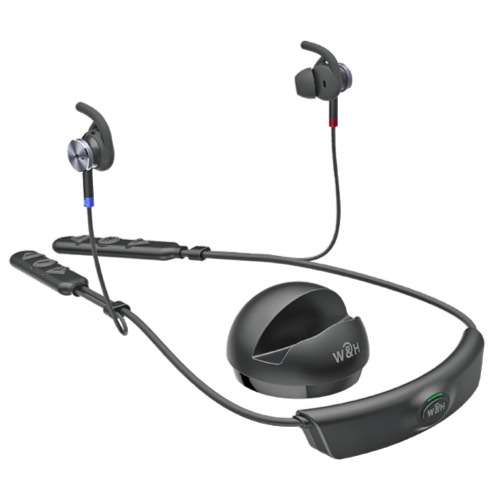
BeHear amplifiers cost more than our other top picks but utilize more technology. BeHear ACCESS II looks like a stereo headsets with earbuds. BeHear ACCESS II has a telecoil, a feature you won’t find in many other hearing amplifiers.
BeHear PROXY wraps around the shoulders with speakers near the ear. Those who wear hearing aids can benefit from this design for situation-specific sound enhancement. You can also use BeHear PROXY with the included earbuds to watch TV, listen to music or make private hands-free phone conversations.
BeHear devices use a mobile app with a hearing assessment to create custom profiles for indoors, outdoors, crowds and live music. You can fine-tune profiles and update your hardware via the mobile app at any time. A notable accessory is HearLink PLUS, a transmitter that streams analog and digital signals for distortion-free music and television audio.
Warranty: 1 Year
Return Policy: 30 Days
Includes: Travel case, charging cradle, USB power cord, three types of tips in multiple sizes, wind protection covers, three pairs of ear hooks
Price: $189 to $399 / $10 for additional sets of silicone earbuds and hooks
iBstone K17 Hearing Amplifier Review
Great Design |
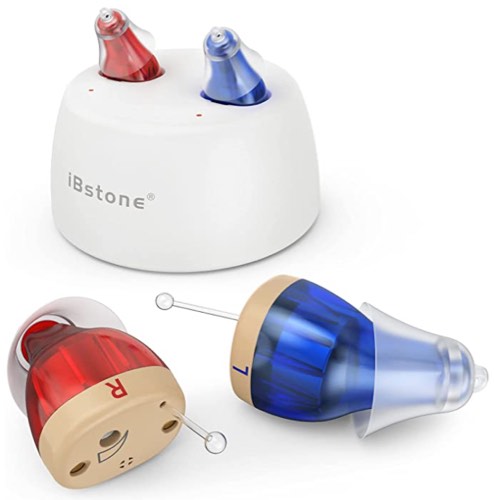
iBstone’s K17 hearing amplifiers are completely-in-canal (CIC) devices, making them less noticeable compared to some other amplifiers. You get a variety of domes to ensure comfortable wear and to reduce feedback.
The iBstone devices feature Ear Protection Output to prevent sudden loud noises from being amplified. The left hearing amplifier is blue and the right is red for quick identification. The outer surface is beige for discreet wear. iBstone K17 amplifiers fully charge in three to four hours and keep the charge for around 24 hours.
The power switch is easy to access while iBstone K17 hearing amplifiers are in your ear. However, you have to remove the devices from the ear canal to adjust the volume. The CIC design makes iBstone K17 hearing amplifiers ideal for use when wearing glasses, a hat or a mask.
Warranty: 1 Year
Return Policy: 30 Days
Includes: Case, charger, power cord and adapter, assorted ear domes, extra filters, volume adjustment tool
Price: $139
Banglijian ZIV-206 Hearing Amplifier Review
Great Warranty |
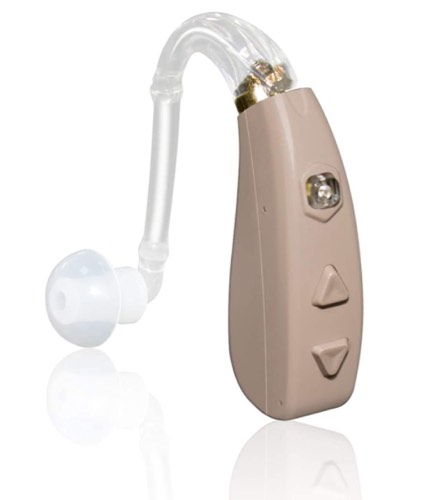
Banglijian ZIV-206 hearing amplifiers are over-the-ear models with transparent sound tubes. The company sells individual amplifiers, and you can use one device in either ear after swapping out sound tubes. However, you get two ZIV-206 amplifiers for a much better price than one. The adjustable 25 to 53 db gain range benefits those with moderate hearing loss and some who have severe hearing loss.
The Bangliijian ZIV-206 is a behind-the-ear (BTE) model that comes with slim and thick tubes and multiple ear domes for the proper fit. Charging time is from one to four hours. Power and volume controls are easy to use while wearing ZIV-206 amplifiers. You get 20 to 24 hours of run time on a full charge.
Banglijian designed ZIV-206 hearing amplifiers with a chip upgrade for solid sound quality across four channels. Use three listening programs and five volume settings to adjust the amplifiers to your environment. You also get speech sound optimization, feedback cancellation and adaptive noise reduction with these hearing amplifiers.
Warranty: 18 Months
Return Policy: 45 Days
Includes: Case, four slim sound tubes with 10 ear domes, three thick sound tubes and 12 ear domes, power adapter and cable, cleaning brush
Price: $139.99 for one device / $169.99 for a pair
Enjoyee Hearing Amplifiers Review
Great Color Selection |
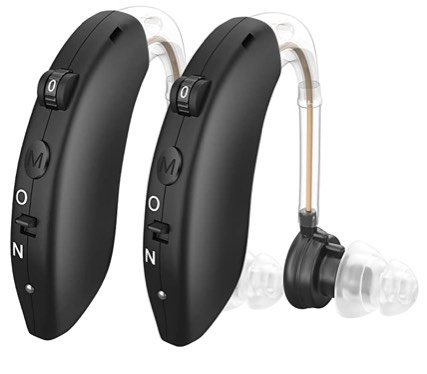
Enjoyee hearing amplifiers come in light and brown skin tones plus blue and black. The earbuds are designed with adjustable angles and include five dome sizes to create a good fit.
Enjoyee hearing amplifiers are water-resistant (not waterproof), making them ideal for active individuals. The company recently upgraded the chip in its amplifiers to provide 30% greater noise reduction. Enjoyee says the amplifiers help all levels of hearing loss, but our research suggests it’s unlikely a hearing amplifier will be adequate for profound hearing loss.
Choose from three frequency modes and four volume levels to adjust to your surroundings. The modes and volume controls are on the BTE unit and are easy to use while wearing. Enjoyee hearing amplifiers charge in two to four hours. The company says you’ll get 80 hours of use from each charge. There is no charging stand or case, and the charging cable plugs directly into an outlet.
Warranty: Not Available
Return Policy: 30 Days
Includes: 10 ear domes, power adapter and cable, two power adapters with USB cables, cleaning brush
Price: $67.99 to $99.95 depending on selected shade
R&L C20 Hearing Amplifier Review
Great Customer Service |
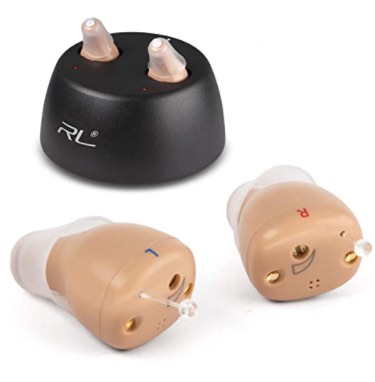
R&L C20 hearing amplifiers are small CIC models that sit in the ear canal. These devices are the simplest on our list of the best hearing amplifiers because you just set the volume and go. R&L C20 amplifiers charge in three to six hours then function for 24 hours.
R&L provides unlimited phone support with U.S.-based customer service weekdays from 8 a.m. until 5 p.m. PST. The company ensures that someone will answer your call. C20 hearing amplifiers are a good choice for those who just need a boost in volume to hear well. If you’re looking for an amplifier with more technology, browse others on our list.
Warranty: 1 Year
Return Policy: 45 Days
Includes: Charging base, bell-shaped and round domes, power adapter and cable, cleaning brush and volume adjustment tool
Price: $139
Neosonic NW10 Hearing Amplifier Review
Great Distance Enhancement |
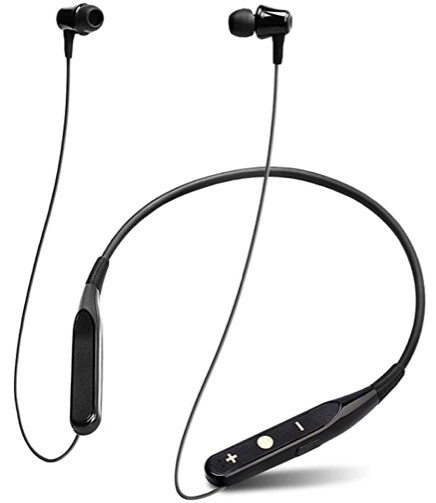
Neosonic’s NW10 hearing amplifiers consist of a thin, flexible neckband with earbuds for each ear. The mic on the neckband amplifies sounds near you while the included remote microphone extends sounds up to 20 yards away. The remote mic looks like a small, lightweight box.
The design is similar to BeHear amplifiers with HearLink Plus, but the level of technology is very different. Neosonic recommends you use the amplifiers with the remote mic in most situations. You pay less for a Neosonic NW10 setup, but BeHear offers more convenience and likely serves a broader range of hearing loss.
The Neosonic NW10 remote mic uses a 2.4G wireless Bluetooth connection. Place the mic in the middle of a table during a meeting to hear all participants or near the TV to hear without disturbing others. You can ask a speaker at an event to wear the small mic on their shirt or place it on their podium.
A three-hour charge gives you up to 20 hours of use with Neosonic NW 10 neckband and 10 hours for the remote mic. Neosonic includes an audio cable to connect the remote mic to a mobile phone or tablet to stream music, podcasts and more to the headset.
Warranty: 1 Year
Return Policy: 45 Days
Includes: Carrying case, dual wall charger, two charging cables, remote amplifier, multiple dome sizes, bands for adjusting earbud wire length, 3.5 mm audio cable
Price: $149.60
Frequently Asked Questions about Hearing Amplifiers
Can loud sounds through a hearing amplifier damage my ears?
Many hearing amplifiers increase sounds very effectively and, without filtering technology, have the potential to damage the inner ear. It’s a good idea to buy hearing amplifiers with noise-canceling technology to avoid this problem.
Why do some hearing amplifier companies call their products hearing aids?
The FTC makes it very clear that hearing aids and hearing amplifiers are not the same devices. We’re not sure why some hearing amplifier companies market the product as hearing aids. Don’t be pulled in by advertising that seems to over-promise, and start your hearing amplifier search using the products on our list.
Are hearing amplifiers comfortable to wear?
Hearing amplifier comfort level depends on the fit and type of device. What works well for one person may not be the best choice for another. Plan to take a couple of weeks to get used to wearing hearing amplifiers. If models styled like hearing aids don’t feel comfortable, you’ll probably prefer a hearing amplifier earbud set.
Why are there not hearing amplifiers with replaceable batteries on your list?
Every hearing amplifier on our list is rechargeable. Charging overnight gets your hearing amplifiers ready to work for a full day. Batteries last over multiple days, but the cost adds up and the tiny hearing aid batteries can be difficult to handle. With rechargeable hearing amplifiers, you never run out of batteries.
Do I need to have my hearing tested to use hearing amplifiers?
You do not need a hearing test or a prescription to buy and use hearing amplifiers. However, there are many causes for hearing loss, and we recommend seeing a doctor to rule out health problems.
Conclusion
Bottom line:
If you frequently ask yourself if you need a hearing amplifier, you probably do.
Struggling with hearing loss is frustrating, causes miscommunications and reduces the quality of your social life. Not hearing well while driving or taking a walk can be dangerous. While hearing aids can be the solution to hearing well, many people are concerned about the cost. Hearing amplifiers are affordable, easy to use and come in many comfortable styles.
The Best Hearing Amplifiers
| Expert Review | Company | |
|---|---|---|
| 1 | Great Design | iBstone K17 Hearing Amplifier |
| 2 | Great Warranty | Banglijian ZIV-206 |
| 3 | Great Color Selection | Enjoyee Hearing Amplifiers |
| 4 | Great Customer Service | R&L C20 Hearing Amplifier |
| 5 | Great Distance Enhancement | Neosonic NW 10 Hearing Amplifier |
| 6 | Great Selection | BeHear Amplifiers |

